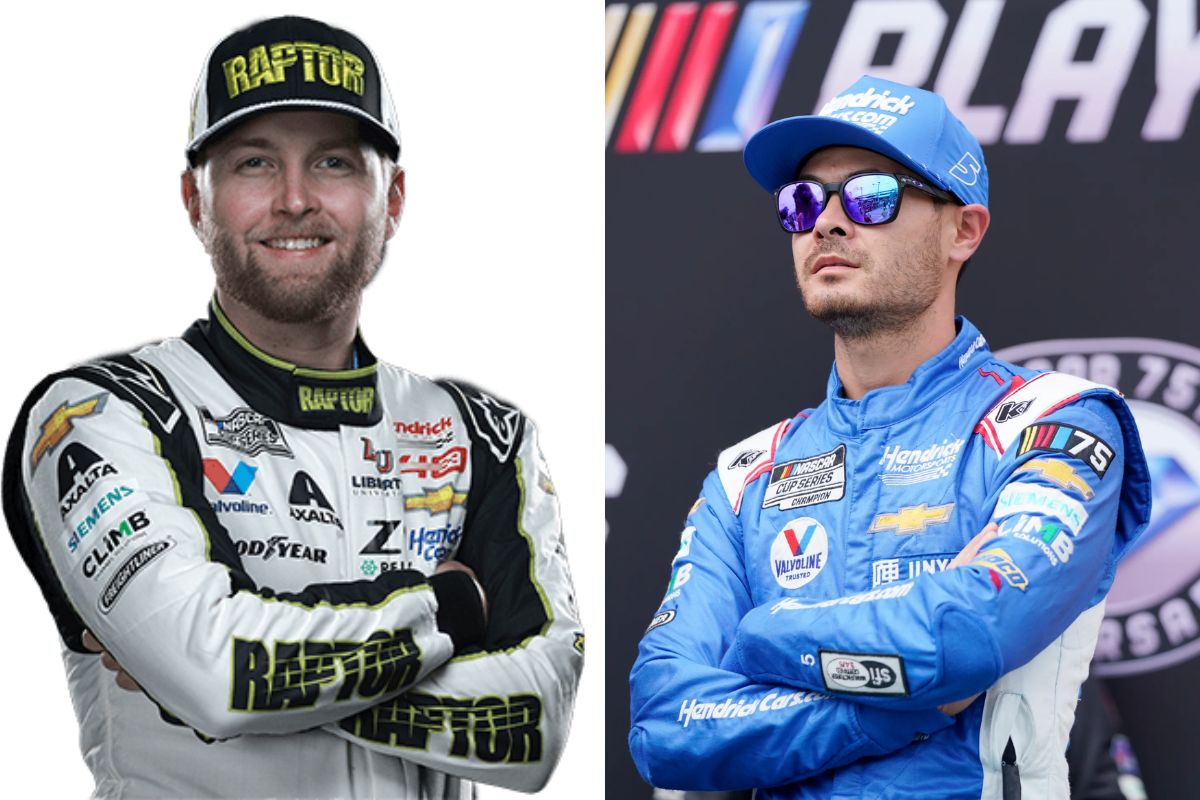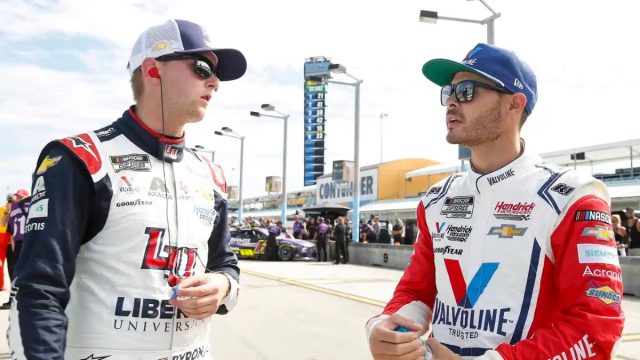Kyle Larson’s Defeat by William Byron: In a turn of events that left NASCAR enthusiasts and analysts in a state of surprise, William Byron’s victory over Kyle Larson at Martinsville not only highlighted the unpredictability inherent in racing but also showcased the strategic prowess and depth of talent within Hendrick Motorsports. Larson, a strong competitor with a track record of excellence, was outsmart in a race that many had anticipated would add to his prestige. This outcome demands a closer examination of the dynamics and strategies at play within one of NASCAR’s premier teams, raising questions about the internal competition and its implications for the team’s future successes.
Key Takeaways
- William Byron’s exceptional performance outpaced teammate Kyle Larson, leading to a surprising victory.
- Larson acknowledged the intense competition and strategic execution by Byron throughout the race.
- Despite leading all 80 laps of Stage 1, Larson could not maintain his dominance against Byron.
- The race highlighted Hendrick Motorsports’ depth of talent and strategic prowess, with a near-perfect podium sweep.
- Larson’s defeat by Byron marked a significant moment, celebrating Hendrick Motorsports’ 40th anniversary with a memorable victory.
Hendrick Motorsports Dominance at Martinsville
The recent race of Cook Out 400 at Martinsville not only highlighted Hendrick Motorsports’ continued supremacy in the NASCAR series but also demonstrated their strategic prowess and depth of talent, marking their 40th anniversary with a near-perfect podium sweep. This performance is a validation of the organization’s enduring commitment to excellence and its ability to consistently leverage its resources and expertise to dominate the competition.
Analyzing the race’s dynamics, it becomes evident that Hendrick Motorsports’ strategy was carefully planned and perfectly executed. The team’s ability to adapt to the evolving conditions on the track and make split-second decisions that optimized their drivers’ performance was crucial. This adaptability, coupled with a deep understanding of the Martinsville Speedway’s unique characteristics, played a significant role in their success.
Furthermore, the race highlighted the depth of talent within the Hendrick Motorsports roster. With drivers finishing in the top three spots, it was clear that the team does not rely on a single star but creates a lineup of capable competitors who can all deliver top-tier performances. This collective strength is a powerful asset, making the team a consistent threat in the NASCAR series.

Larson’s Perspective on the Race
Kyle Larson, reflecting on his recent performance, acknowledged the intense competition from teammate William Byron, despite having secured the pole position and leading the initial stage of the race. Larson’s anticipation of Byron’s aggressive approach was rooted in their shared history of closely contested races and mutual respect as teammates. Having won his second consecutive NASCAR Cup Series pole, Larson demonstrated his prowess and strategic decision by delivering a stellar lap time during the final moments of qualifying. This achievement not only highlighted his skills as a driver but also set high expectations for his performance in the race.
During the competition, Larson’s dominance was evident as he led for all 80 laps of Stage 1, showcasing his ability to maintain pace and navigate the track efficiently. However, the race’s dynamics shifted in Stage 2, with Denny Hamlin overtaking Larson and demote him to second place. This change in position emphasized the unpredictable nature of racing, where strategic decisions and split-second reactions can greatly alter the outcome. Larson’s subsequent loss to Byron was a reflection of the high level of competition within the team and the sport as a whole.
Analyzing Larson’s perspective, it becomes clear that his anticipation of Byron’s challenge was not baseless. The intra-team rivalry, while friendly, serves as a motivation for both drivers to push their limits and continuously improve. Larson’s ability to lead the initial stage, coupled with his strategic mindset, highlights his status as a strong competitor. Despite the eventual outcome, Larson’s performance in the race shows the fine balance between skill, strategy, and adaptation that defines success in NASCAR.
Larson Reflects on the Race Outcome
Reflecting on the race’s outcome, Larson acknowledged the exceptional performance of his teammate William Byron, emphasizing the significance of their team’s overall achievement with a top-three finish. Larson’s analysis did not just stop at congratulating Byron but extended to recognizing the strategic execution that led to Byron’s victory. He pointed out Byron’s skillful handling following a critical green flag stop, which basically set the stage for his lead. This moment was not just about Byron’s win but a proof to the team’s prowess and strategic planning.
Larson’s reflection also highlighted the broader success of Hendrick Motorsports, marking it as a memorable day for the team. With 1,500 Hendrick Motorsports employees in attendance, the victory was not just for Byron but served as a celebration of the team’s legacy and a validation of their collective effort and strategy that have been refined over 40 seasons.

The Race Dynamics and Potential Challenges
As the race neared its conclusion, highlighting the perfect balance between teamwork and rivalry within NASCAR’s high-stakes environment. Understanding the dynamics at play, Larson was acutely aware of the multidimensional challenges that could emerge in the final laps, where the thin line between collaboration and competition often blurs, leading to unpredictable outcomes.
- Strategic Drafting Tactics: Utilizing the aerodynamic advantage by staying close behind a competitor, known as drafting, can offer a significant speed boost. Larson was aware that Elliott and Byron might employ this tactic aggressively in the closing stages to slingshot past him.
- Team Dynamics: Despite being teammates, the intense desire to win can sometimes override alliances. Larson was prepared for the possibility that internal team strategies could shift rapidly, especially if it meant securing a victory for Elliott or Byron.
- Tire Wear and Fuel Management: The end of the race often sees vehicles pushed to their limits, with tire degradation and fuel levels becoming critical factors. Larson had to navigate these physical limitations while also contending with his rivals’ tactics.
- Psychological Mind Games: The high-pressure environment can lead to psychological games among drivers, with attempts to outsmart each other mentally. Larson was aware that maintaining focus and not falling for intimidation or frustration was vital.
If you gotta finish 2nd, that's probably the best way to do it. @KyleLarsonRacin checks in with @ReganSmith after Martinsville. pic.twitter.com/VaazroxsBt
— FOX: NASCAR (@NASCARONFOX) April 7, 2024
Larson’s Assessment and Outlook
Analyzing his performance and the day’s developments, Larson candidly discussed the car’s velocity and outlined the strategic tactics that could enhance his chances in the upcoming races. With a victory already under his belt this season, securing a position in the playoffs, Larson acknowledged the importance of harnessing the car’s speed to its maximum potential. He emphasized the detail understanding of race dynamics, indicating a wise approach to analyzing track conditions and opponent strategies.
Larson’s reflections on the day’s events shed light on a critical aspect of competitive racing—adaptability. His ability to understand the race’s complexity, from aerodynamics to tire wear, outlines a deep engagement with the sport’s technical dimensions. The emphasis on velocity points to an ongoing quest for optimization, suggesting that even minor adjustments could translate into significant performance gains.
Furthermore, Larson’s outlook for the future is rooted in a strategic evaluation of his team’s capabilities and the competitive landscape. By focusing on incremental improvements and leveraging his team’s strengths, Larson appears self-assured to address the challenges ahead with a mix of confidence and technical knowledge. This approach, grounded in a realistic assessment of his current standing and the inherent unpredictability of racing, signals a mature perspective on the path to potential victories.

News in Brief
The surprising defeat of Kyle Larson by William Byron at Martinsville highlights the unpredictability and competitive nature of NASCAR racing. This event not only showcases Hendrick Motorsports’ dominance and strategic prowess but also emphasizes the importance of teamwork and adaptability within the sport.
The outcome demonstrates the depth of talent within the team and the critical role of strategic execution in determining race results. Moving forward, this incident may influence future racing strategies and team dynamics, creating a more competitive environment within NASCAR.
Our Reader’s Queries
Q: Has William Byron ever won a NASCAR race?
A: In his seventh season piloting the No. 24 Hendrick Motorsports Chevrolet, William Byron boasts 12 career victories. His most recent victory was in March 2024, pull off the win at the EchoPark Automotive Grand Prix at Circuit of The Americas.
Q: What car does Kyle Larson drive?
A: Kyle Miyata Larson, born on July 31, 1992, is a prominent American auto racing driver. He holds a full-time position in the NASCAR Cup Series, steering the No. 5 Chevrolet Camaro ZL1 under the banner of Hendrick Motorsports. Additionally, Larson participates part-time in the NASCAR Xfinity Series, driving the No. 17 Chevrolet Camaro for the same esteemed team
Also Read: Kyle Larson Wins Cook Out 400 Pole: Dramatic Qualifying Twist Unfolds!
